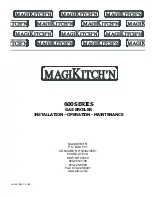
56
during installation:
– Insulate the exhaust pipe and install a
condensation collection system at the
base of the vertical pipe.
– If the pipe passes through combustible
walls, insulate the section of the flue pipe
passing through the wall with a 30 mm
thick fibreglass pipe covering with a den-
sity of 50 kg/m
3
.
In
“BF”
models this type of exhaust pipe is
installed using the special kit, code
8089904. For kit assembly instructions,
refer to point 2.9.1.
Protect the intake with the optional acces-
sory, code 8089501.
The accessory is assembled by cutting a 50
mm long segment from an ordinary ø 80
extension and inserting it on the air intake,
on which the accessory is then fitted, ancho-
red to the pipe segment with the screws pro-
vided (fig. 10).
Kit code 8089904 is supplied with the
intake diaphragm, which must be used as
shown in fig. 8/a, depending on the maxi-
mum permitted flow.
Maximum flow resistance must be no
more than 7.6 mm H
2
O in vers. “23 BF” - 9
mm H
2
O in vers. “28 BF”.
As the maximum pipe length is determined
by adding up the flow resistance of the
various individual accessories installed, refer
to
Table 1
for calculation.
2.10
POSITIONING OF OUTLET
TERMINALS
The outlet terminals for forced draught
systems may be located on the outer walls
of the building.
Table 2
shows approximate,
non-binding minimum distances to be met
for a building of the type shown in fig. 11.
2.11
ELECTRICAL WIRING
If you must replace the electric power
cable supplied with the boiler, order it exclu-
sively from CLIMIT.
The power supply must be single-phase
230V - 50 Hz through a main switch pro-
tected by a fuse with a distance of at least
3 mm between contacts.
NOTE: The boiler must be connected with
an efficient grounding system. CLIMIT
shall not be held liable for injury or dama-
ge resulting from failure to ground the boi-
ler.
2.11.1
Electrical panel
(fig. 12)
Before performing any kind of operation,
disconnect the unit from the power supply
TABLE 2
Siting of terminal
Appliances from 7 to 35 kW
(distances in mm)
A - below openable window
600
B - below ventilation opening
600
C - below eaves
300
D - below balcony (1)
300
E - from adjacent window
400
F - from adjacent ventilation opening
600
G - from horizontal or vertical soil or drain pipes (2)
300
H - from corner of building
300
I - from recess in building
300
L - from ground level or other treadable surface
2500
M - between two terminals set vertically
1500
N - between two terminals set horizontally
1000
O - from a surface facing without
openings or terminals
2000
P - as above but with openings and terminals
3000
1) Terminals below a practicable balcony must be located in such a way
that the total path of the smoke from its outlet point from the termi-
nal to its outlet point from the external perimeter of the balcony,
including the height of possible railings, is not less than 2000 mm.
2) When siting terminals, where materials that may be subject to the
action of the combustion products are present in the vicinity, e.g.,
eaves, gutters and downspouts painted or made of plastic mate-
rial, projecting timberwork, etc., distances of not less than 1500
mm must be adopted, unless adequate shielding is provided to
guard these materials.
Fig. 11
50
cod. 8089501
Fig. 10















































